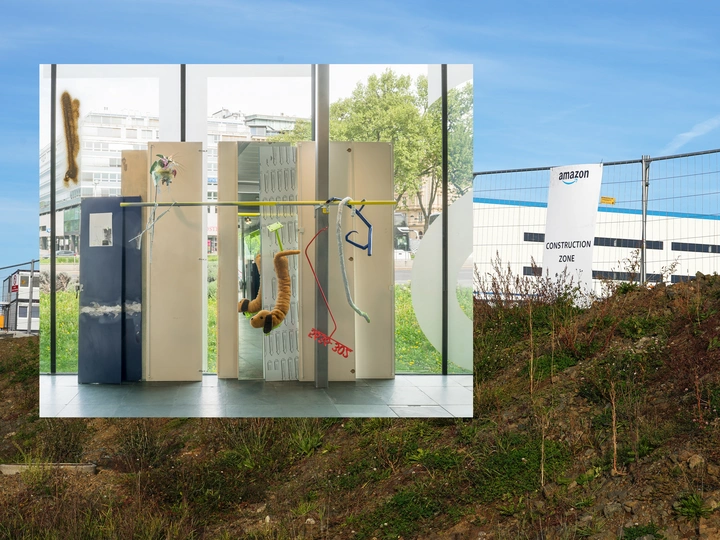Infrastructural temporalities & cycles of storing

Michael Reindel
Michael Amadeus Reindel (*1993) spent his childhood in-between the highway junction Bayrisches Vogtland and an abandoned gravel quarry. In 2020 Amazon has built a logistic center in the immediate vicinity. Connected through a highway junction, the company’s global logic of organization and distribution now stands in direct relation to the artist’s biography and his artworks. Within this relational network his sculptures are constantly being disassembled, transformed, re-assembled and embedded in the given geopolitical narratives and infrastructural conditions. In doing so, the often collectively developed works question the current economic, social and cultural model in relation to its environmental crises. Together with the artist and filmmaker Vik Bayer, he realized several multimedia research installations and developed, bound and published the book “Material Notions of Seeding”. The book deals with the question of how we – as people working within spatial culture – could learn from the practice of eco activist and scientist Vandana Shiva. Amongst other contributions, the book also contains an interview with Martin Rauch.
To learn and participate in the inevitable transformation of the present and the building sector as such he worked with various changemakers. While working at Martin Rauch’s company he gained a lot of experience and insights in the pre-fabrication of rammed earth fragments, the challenges and new possibilities which come with scaling up the production of non-standardized building materials and the complex aspects of logistics and assemble on sight. For the exhibition “The Great Repair” he worked with Material Culture and Bauhaus Earth to realize the exhibition contribution. During the mentioned works and a workshop with Atelier Fanelsa he gained a lot of knowledge working with biobased materials, but also how a regenerative practice is organized at the intersection of design, research and strategic thinking toward a post-carbon circular world.
For three years I am working on a project in a village in Oberfranken which started from a house and its embeddedness within its infrastructural surrounding. Its network contains an abandoned gravel quarry that belongs to the European network of nature protection areas “Natura2000”, Germany’s biggest organic supermarket chain and a newly built Amazon Fulfillment Center. While mapping this infrastructural setting, the main question within my artistic research circulates about care-taking. All of the mentioned protagonists claim to take care of the environment. But who really does?
Global platform companies transform our ecologic, geopolitical and socioeconomic landscape. The often-accompanying philanthropic programs and foundations are permeated by the narrative of caring for the environment. In doing so they turn nature in profitable asset. Companies like Amazon are reorganizing landscapes to their infrastructural needs – in this case the storing and transport of goods and data.
Within my proposal I explore how a regenerative storage unit counters this notion of storing which is informed by a rapidly repetitive and extractive infrastructural temporality. According to the local development strategies paper “LEADER 2023-2027“ the region is labeled as in particular need for action. The increasing land consumption threatens the ecological and sustainable reorganization of the landscape, for example the huge monocultural surrounding forests (Frankenwald). The proposed regenerative storage unit contains carbon sequestering materials, information on their circularity and temporalities and speculates on implementing them within the surrounding landscape of storage places, logistic centers and highways. My proposal doesn’t stop with speculating. To represent how these yet to be identified materials once harvested could be processed within a regional value chain I will develop 1:1 models, artefacts and informational walks and interventions through the landscape.